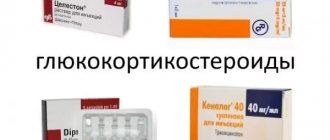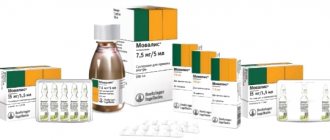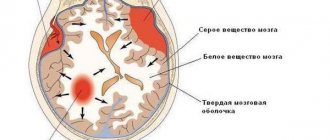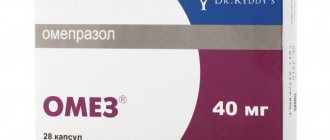Zaldiar (tablets)
Tramadol and paracetamol are quickly and almost completely absorbed from the gastrointestinal tract. Tramadol is used in racemic form; both (+) and (-) forms and the M1 metabolite are detected in the blood. Although tramadol is rapidly absorbed after oral administration, its absorption is somewhat slower and its half-life is longer than that of paracetamol.
After a single oral dose of tramadol hydrochloride/paracetamol tablets (37.5 mg/325 mg), the maximum concentrations of tramadol in the blood plasma are 64.3/55.5 ng/ml (+ and - forms, respectively) are determined after 1.8 hours, and paracetamol 4.2 mcg/ml after 0.9 hours. The half-life (T1/2) is 5.1/4.7 hours for tramadol [(+)-tramadol/(-)-tramadol] and 2.5 hours for paracetamol.
Suction
Tramadol is rapidly and almost completely absorbed after oral administration. The average absolute bioavailability is approximately 75% with a single 100 mg oral dose of tramadol. With repeated oral administration of tramadol, bioavailability increases to approximately 90%.
After taking the drug Zaldiar® orally, the absorption of paracetamol occurs quickly and almost completely, mainly in the small intestine. Maximum concentrations of paracetamol in blood plasma are reached within one hour and do not change when used simultaneously with tramadol.
Taking Zaldiar® orally during meals does not have a significant effect on the maximum concentration of active substances in the blood plasma or on the degree of absorption of tramadol or paracetamol in the gastrointestinal tract, which makes it possible to take Zaldiar® both with meals and regardless of meals.
Distribution
Tramadol has a high affinity for tissues (Vd, β = 203 ± 40 l). Plasma protein binding is approximately 20%.
Paracetamol is widely distributed in most tissues of the body (except fat). Its apparent volume of distribution is about 0.9 l/kg. A relatively small part (~20%) of paracetamol is bound to plasma proteins.
Metabolism
Tramadol is actively metabolized after oral administration. About 30% of the dose is excreted unchanged in the urine, 60% of the dose is excreted in the form of metabolites.
Tramadol is metabolized by O-demethylation (catalyzed by the CYP2D6 isoenzyme) to the M1 metabolite (O-demethyltramadol) and by N-demethylation (catalyzed by the CYP3A isoenzyme) to the M2 metabolite (N-demethylated metabolite). Metabolite M1 is metabolized through N-demethylation followed by conjugation with glucuronic acid. The half-life of the M1 metabolite is 7 hours. The M1 metabolite is superior to tramadol in its analgesic activity. The concentration of the M1 metabolite in the blood plasma is several times lower than the concentration of tramadol, therefore, with repeated use, the significance of this metabolite in the overall clinical effectiveness of the drug does not change.
Paracetamol is metabolized primarily in the liver in two main ways: glucuronidation and sulfation. The latter can be quickly saturated when taking doses of the drug that exceed therapeutic doses. A small part of the dose taken (less than 4%) is metabolized by cytochrome P450 to the active metabolite, N-acetyl-benzoquinoneimine, which, when used in therapeutic doses, is quickly neutralized by reduced glutathione and excreted in the urine after conjugation with cysteine and mercapturic acid. With an overdose of paracetamol, the concentration of N-acetyl-benzoquinone imine in the blood plasma increases significantly.
Removal
Tramadol and its metabolites are mainly excreted in the urine. In adults, the half-life of paracetamol is approximately 2 to 3 hours. The half-life of the drug in children is shorter; in newborns and patients with liver cirrhosis it is slightly longer. Paracetamol is mainly eliminated from the body through the dose-dependent formation of glucuronidated and sulfoconjugated derivatives. Less than 9% of paracetamol is excreted unchanged in the urine. In renal failure, the half-life of tramadol and paracetamol increases.
Zaldiar®
When Zaldiar is used together with opioid agonists-antagonists (buprenorphine, nalbuphine, pentazocine), the analgesic effect is reduced as a result of a competing effect on receptors and there is a risk of withdrawal syndrome, so the use of this combination is not recommended.
When treated with Zaldiar together with other drugs that have a depressant effect on the central nervous system (for example, hypnotics or tranquilizers), as well as while taking ethanol, the side effects characteristic of tramadol may be more pronounced.
Naloxone, being an opioid receptor antagonist, activates breathing, eliminating the analgesia caused by Zaldiar.
Inducers of microsomal oxidation (including carbamazepine, phenytoin, ethanol, barbiturates, rifampicin, phenylbutazone, tricyclic antidepressants) reduce the analgesic effect of Zaldiar and its duration.
Inhibitors of microsomal oxidation (including cimetidine), when used simultaneously, reduce the risk of hepatotoxic action of Zaldiar.
Long-term use of barbiturates reduces the effectiveness of paracetamol.
Long-term combined use of paracetamol and NSAIDs increases the risk of developing nephropathy and renal papillary necrosis, and the onset of end-stage renal failure. Simultaneous long-term administration of paracetamol in high doses and salicylates increases the risk of developing kidney or bladder cancer.
Concomitant use of Zaldiar with drugs that lower the seizure threshold (for example, selective serotonin reuptake inhibitors, tricyclic antidepressants, antipsychotics) may increase the risk of seizures.
Zaldiar, when used simultaneously for a long time, enhances the effect of indirect anticoagulants (warfarin and other coumarins), which increases the risk of bleeding.
Drugs that inhibit CYP3A4, such as ketoconazole and erythromycin, may slow the metabolism of tramadol (N-demethylation) and the active O-demethylated metabolite.
Diflunisal increases the plasma concentration of paracetamol by 50%, and the risk of hepatoxicity increases.
Quinidine increases the plasma concentration of tramadol and reduces the concentration of the M1 metabolite due to competitive inhibition of the CYP2D6 isoenzyme.
The rate of absorption of paracetamol may be increased by concomitant use of metoclopramide or domperidone and reduced by concomitant use of cholestyramine.
Instructions for use of Zaldiar (Method and dosage)
Instructions for use of Zaldiar recommend swallowing the tablets whole, without chewing and drinking water, and does not advise connecting the use of the drug with food intake. If you missed taking the next pill, you should not double the dosage the next time you take it.
The dosage regimen is set individually, as is the duration of treatment, depending on the degree of pain and the patient’s condition.
For adults and children over 14 years of age, the initial single dose is set at 1-2 tablets, the time between doses of such doses is six hours. The highest daily dose is 8 tablets, which corresponds to 2.6 g of paracetamol and 300 mg of tramadol.
Contraindications
- Sensitization to the components of the drug;
- acute intoxication with drugs that suppress the nervous system ( hypnotics, opioids or psychotropic drugs) or alcohol;
- severe liver or kidney damage;
- simultaneous administration with MAO inhibitors and a two-week period after their discontinuation;
- uncontrolled epilepsy ;
- age less than 14 years;
- withdrawal syndrome .
Zaldiar should be used with caution in patients with traumatic brain injury , in a state of shock , with intracranial hypertension , a tendency to convulsions , cryptogenic confusion, impaired respiratory function, simultaneous use with psychotropic drugs, other painkillers of central and local action, benign hyperbilirubinemia , diseases hepatobiliary system, viral hepatitis , deficiency of glucose-6-phosphate dehydrogenase , alcoholism , alcoholic changes in the liver, drug addiction , with symptoms of “ acute abdomen ” of unknown origin, in the elderly.
Overdose
Signs of tramadol : vomiting, miosis, collapse, depression of the respiratory center, convulsions, coma, apnea.
Signs of paracetamol : diarrhea , loss of appetite; if recommended doses are exceeded for 2-4 days - hypocoagulation, cerebral edema, disseminated intravascular coagulation syndrome, metabolic acidosis, hypoglycemia, arrhythmia, collapse . Rarely, fulminant development of liver dysfunction, including renal failure .
Therapy: gastric lavage, administration of enterosorbents , control and normalization of parameters of the cardiovascular and respiratory systems.
In case of respiratory depression (as a symptom of tramadol ), administration of naloxone ; for convulsions - use diazepam . Hemodialysis or hemofiltration are ineffective for the removal of tramadol .
If signs of paracetamol , it is recommended to administer precursors for glutathione and SH-group donors ( methionine ).
Zaldiar is a new combination drug for the treatment of pain syndromes
Pain is a general biological adaptive reaction that signals the presence of pathological abnormalities, warns and protects the body from damage. Often this protective meaning of pain is lost and it becomes a serious medical problem. The resulting pain sensation leads to the activation of stress-limiting systems that have central, autonomic and humoral components. But when pain becomes excessive and prolonged, it can lead to regulatory maladaptation. Pain increases the load on almost all vital systems of the body. Tachycardia, hypertension, arrhythmia occur, breathing becomes more frequent and its depth decreases, vital capacity and FRC decrease, motor activity decreases, the patient assumes a forced position, and a depressive state may develop. Subjectively felt pain is difficult to objectively quantify, and is perceived by the consciousness of the victim to varying degrees in intensity and character. These differences are a consequence not only of different susceptibility to painful effects, but also of the location and nature of the causes - from short-term pathogenic effects to a condition accompanied by persistent chronic pain. In clinical practice, the types of pain shown in Figures 1-3 are distinguished. The division of pain into somatic superficial, arising from irritation of nociceptors of the skin and subcutaneous layers, somatic deep, the source of which is muscles, fascia, ligaments, joints, periosteum and visceral, which reflects diseases or dysfunction of the chest and abdominal organs, is of practical importance in diagnostics and pharmacotherapy. Pain occurs when pain receptors (nociceptors, algoreceptors), pathways, or directly the nuclei of the nociceptive analyzer are irritated. Signals arising in nerve endings during the action of painful stimuli are conducted to the cerebral cortex, where they are perceived, along a three-neuron pathway (Fig. 4). To suppress pain, primarily peripheral and thalamo-cortical neurons are available, and only occasionally influence on spinothalamic neurons is possible. The mechanism of pain is multifactorial, and its formation involves physical (mechanical and temperature) and chemical influences. Among the chemical agents, the most effective endogenous algic substances are: bradykinin and kalidin, histamine, serotonin, prostaglandins, hydrogen and potassium ions. Prostaglandins play a significant role in the mechanism of pain. Algogenic substances have an irritating effect, forming a pain syndrome; in addition, they can mutually enhance each other’s actions and reduce the threshold of sensitivity of nociceptors to the action of other pathogenic factors. Currently, taking into account the multifactorial mechanism of pain development, general principles for the treatment of pain syndromes have been developed: 1. Treatment of pain should be, if possible, etiopathogenetic (i.e., aimed at eliminating the causes of pain), and not symptomatic. 2. A unified tactics for the treatment of pain syndromes is used, based on strict compliance of the prescribed painkillers depending on their intensity. The intensity of pain is established on a simple scale: The division of pain into 4 stages is of great importance for the choice of analgesics. Mild pain (1 point) should be eliminated with non-narcotic analgesics. For moderate pain (2 points), it is advisable to prescribe non-narcotic opioid analgesics in combination with non-steroidal anti-inflammatory drugs (NSAIDs) and/or non-narcotic analgesics. Indications for the prescription of potent narcotic drugs (morphine, promedol, etc.) should be established only for severe and very severe (3–4 points) acute pain syndrome. This tactic of prescribing pain medications helps prevent the unjustified prescription of potent drugs to patients who do not need them and avoid possible complications and side effects. In addition to the digital scale, a visual analog scale in the form of a ruler can be used:
No pain Moderate pain Severe pain
3. The pain reliever prescribed by the doctor must be adequate to the intensity of the pain and safe for the patient, i.e. should relieve pain without causing serious side effects. If an analgesic is prescribed that is insufficient to eliminate pain, the pain persists and begins to rapidly increase due to the summation of painful stimuli and overexcitation of the pain-conducting nerve structures; As a result, a pain syndrome that is difficult to eliminate is formed, sometimes becoming chronic. It is unjustified to prescribe too strong a narcotic for mild or moderate pain. There are known cases of severe complications in young patients in the early stages after minor surgical interventions as a result of the prescription of morphine and other powerful opiates for pain relief, which led to deep drug-induced depression of the central nervous system, depression of breathing and circulation. 4. Monotherapy with drugs for any pain syndrome (including severe pain) should not be used. In order to increase the effectiveness and safety of pain relief, the drug should always be combined with non-narcotic analgesics, selected in accordance with the pathogenesis of a particular pain syndrome. A number of authors recommend the use of combination therapy with various groups of drugs, in particular a combination of narcotic and non-narcotic analgesics, which avoids addiction, slows down the formation of drug dependence, allows the use of smaller doses of drugs and achieve a good analgesic effect. Recently, in the treatment of pain syndromes, much attention has been paid to the use of nonsteroidal anti-inflammatory drugs (NSAIDs). Drugs in this group (acetylsalicylic acid, indomethacin, diclofenac, ketoprofen, ketorolac, ibuprofen, piroxicam, etc.) have long been used in medicine due to their ability to suppress inflammation, reduce body temperature and pain intensity. Their mechanism of action is that they block the synthesis of prostaglandins by inhibiting the enzyme cyclooxygenase, which catalyzes the conversion of arachidonic acid and the formation of a number of prostaglandin precursors. Prostaglandins are algogenic substances, but, in addition, they are mediators of the inflammatory reaction in tissues and cause tissue swelling, vasodilation, and fever. The administration of NSAIDs helps to inhibit or completely eliminate the inflammatory response. When used, consciousness, hemodynamics and breathing are not depressed, and autonomic reactions are stabilized. Unfortunately, taking non-steroidal anti-inflammatory drugs is associated with the development of NSAID-induced gastropathy, manifested by erosions (often multiple) and ulcers of the antrum of the stomach and/or duodenum. The main risk factors for their development are the elderly age of patients, a history of peptic ulcer disease, combined therapy with NSAIDs and glucocorticoids, long-term treatment with high doses of NSAIDs or simultaneous use of two or more drugs in this group. For the prevention and treatment of NSAID-induced gastropathy, the entire arsenal of antiulcer drugs is used: proton pump inhibitors (omeprazole 20–40 mg/day, lansoprazole 30–60 mg/day, etc.), H2-histamine receptor blockers (famotidine), synthetic analogue of PGE1 - misoprostol, etc. One of the safest non-narcotic analgesics is paracetamol (acetaminophen). Paracetamol blocks cyclooxygenase only in the central nervous system, affecting the centers of pain and thermoregulation. In inflamed tissues, the effect of paracetamol on cyclooxygenase is neutralized by cellular peroxidases, which explains the almost complete absence of anti-inflammatory effect. An important advantage of paracetamol over other non-narcotic drugs and NSAIDs is the lack of influence on the synthesis of prostaglandins in peripheral tissues, which results in the absence of a negative effect on water-salt metabolism (sodium and water retention) and, most importantly, on the mucous membrane of the gastrointestinal tract (GIT) ), therefore the drug does not cause erosion of the gastrointestinal tract. Paracetamol does not have an inhibitory effect on the synthesis of thromboxane A, so the drug has virtually no effect on the hemostatic system. Side effects when using paracetamol are very rare. With long-term use and in large doses, hepatotoxicity may develop. The indication for the use of paracetamol is pain of mild to moderate intensity. The drug is widely used for postoperative pain relief during various interventions. An effective combination of paracetamol and opiates has been noted. For example, the combined use of paracetamol and morphine can reduce the daily dose of morphine by 46%, reduce the incidence of side effects and achieve a good analgesic effect in 87% of patients undergoing orthopedic surgery. According to statistics, in medical practice the most common pain syndromes are of moderate intensity, in which non-narcotic analgesics are no longer effective enough, and narcotic ones are not yet indicated or are not readily available [Osipova N.A., 2006]. The main drugs for the treatment of such pain syndromes are opioids of medium analgesic potency - codeine and tramadol, which have a number of important positive properties. In particular, unlike codeine, it is not a narcotic analgesic. Tramal (tramadol) is a synthetic opioid analgesic with central action. At the level of the brain and spinal cord, it causes hyperpolarization of neuron membranes and inhibits the conduction of pain impulses. Tramal destroys catecholamines, which have a depressing effect on nociception, and stabilize the content of catecholamines in the central nervous system. Tramal is a selective agonist of m-opioid receptors, selectively inhibits the reuptake of serotonin and norepinephrine. Tramal's affinity for opioid receptors is 10 times weaker than codeine and 6000 times weaker than morphine. In terms of analgesic effect, Tramal is 4–5 times weaker than morphine. In therapeutic doses, Tramal has virtually no effect on hemodynamics and respiration, slightly slows down intestinal motility, without causing constipation. Has some sedative effect. The indication for the use of Tramal is acute and chronic pain syndrome of severe and moderate intensity, including postoperative pain syndrome. Compared to pure agonists (morphine, promedol), side effects are rare and manifest themselves in the form of dizziness, weakness, some lethargy, dry mouth, nausea, and allergic reactions. Tramal has high bioavailability through various routes of administration (68–100%), surpasses codeine in analgesic action and is the safest of all opioids [Osipova N.A., 2006]. In medicine, combinations of various analgesics with different mechanisms of action have long been used in order to increase their analgesic effects without increasing the number of side effects. One of the most successful modern combined analgesics is Zaldiar, produced by a pharmaceutical company (Germany), which contains 325 mg of paracetamol and 37.5 mg of tramadol. This rational combination allows you to achieve high-quality pain relief, while the analgesic effect is more pronounced than with a double dose of each of these drugs, with a significant reduction in side effects. Paracetamol and Tramal (tramadol) are effective analgesics that have different complementary mechanisms and have different pharmacotherapeutic properties. Tramadol is characterized by a long-lasting effect with a delayed onset, while paracetamol has an effect that occurs fairly quickly. The combination of paracetamol and Tramal allows you to achieve a more pronounced, longer-lasting analgesic effect in a short time [Langford R., 2006]. Zaldiar is indicated for acute and chronic pain syndrome of moderate and severe intensity. The drug is a film-coated tablet. When taken orally, the drug is quickly and almost completely absorbed from the gastrointestinal tract; the expected effect begins within a few minutes. Zaldiar has no side effects of NSAIDs, and it can be used in patients with gastropathy, gastric and duodenal ulcers. A single dose for adults is 1–2 tablets, the maximum daily dose is up to 8 tablets. Studies have shown that Zaldiar provides adequate pain relief for various acute and chronic pain syndromes. For example, in the treatment of postoperative pain, chronic cancer pain syndrome, for perioperative analgesia, including preoperative pain syndrome, pain syndrome in osteoarthritis and osteoarthritis, in the treatment of moderate and severe pain in neurology, various fields of surgery, dentistry, traumatology and orthopedics and gynecology . In addition, according to the conclusion of the Russian Anti-Doping Center, this drug does not contain prohibited doping agents and/or their metabolites and can be used in sports medicine. Zaldiar is well tolerated by patients at the indicated therapeutic doses. It is also important that Zaldiar is not included in the lists of the Permanent Drug Control Committee and is not subject to subject-quantitative registration, which greatly facilitates its acquisition, storage and use. Zaldiar expands the possibilities of pain therapy using non-narcotic analgesics. It is used to treat various types of pain syndromes of moderate and severe intensity and deserves wide introduction into clinical practice.
Literature 1. Sviridov S.V. “Rationale for the use of prostaglandin and kininogenesis inhibitors in the complex of general anesthesia and postoperative pain relief” //Anesthesiology and Reanimatology. –1992, – No. 2, – p. 3–9. 2. Shvets P., Shvets A. “Pain and pharmacotherapy of pain” // Slovakofarma review. T.IV., 1994, No. 2–3. 3. Lebedeva R.N., Nikoda V.V. “Pharmacotherapy of acute pain” – M., – 1998. 4. Voznesensky A.G. “Clinical pharmacology of non-steroidal anti-inflammatory drugs” – Volgograd, –1999. 5. Osipova N.A. “Procedure and timing of prescribing narcotic analgesics” Guidelines. M. 1999. 18 p. 6. Osipova N.A., Abuzarova G.R., Khoronenko V.E., Sergeeva I.E. “Zaldiar: new opportunities in the treatment of pain syndromes” // Consilium-medicum. Extra release. 2006. 7. Nasonov E.L. “Non-steroidal anti-inflammatory drugs. Prospects for use in medicine” – M.: – Anko, – 2000, –143 p. 8. Ovechkin A.M., Morozov D.V., Zharkov I.P. “Analgesia and controlled sedation in the postoperative period: realities and possibilities” // Bulletin of Intensive Care. – 2001. – No. 4. 9. Smolnikov P.V. "Pain. Choice of protection” // Moscow, – 2001. 10. Belyakov V.A., Soloviev I.K. “Non-narcotic analgesics” - N. Novgorod, - 2001. 11. Ekstrem A.V., Popov A.S., Kondrashenko E.N. “Mechanisms and treatment of postoperative pain” - Volgograd, - 2003. 12. Langford R. “Tramadol and paracetamol: pharmacological and clinical aspects of a new combination of analgesics” // Consilium-Medicum. Extra release. 2006 13. V.V. Nikoda, V.V. Makarova, A.P. Nikolaev, A.V. Bondarenko “Clinical aspects of the use of analgesics based on tramadol and paracetamol in the treatment of postoperative pain” // Consilium-Medicum No. 6. Volume 06. 2004 14. Butrov A.V., Borisov A.Yu. “Modern approaches to pharmacotherapy of postoperative pain with the use of synthetic opioids and non-narcotic analgesics” // Russian Medical Journal No. 24. Volume 12. – 2004.
Side effects
- From the nervous system: increased fatigue, headache, dizziness, weakness, nervousness, anxiety, spasms , emotional lability, euphoria, hallucinations, lethargy, sleep disturbance, incoordination , confusion, depression , deterioration of cognitive function, amnesia , gait instability, paresthesia , blurred vision or taste;
- allergic reactions: itching , urticaria , angioedema ;
- reactions from the digestive system: vomiting or nausea, dry mouth, flatulence , constipation , abdominal pain, diarrhea , activation of liver enzymes, difficulty swallowing;
- reactions from the hormonal system: hypoglycemia ;
- reactions from the circulatory system: fainting, orthostatic hypotension, tachycardia, collapse ;
- reactions from the respiratory system: dyspnea ;
- reactions from the genitourinary system: dysuria , urinary retention, possible nephrotoxicity if recommended doses are exceeded for a long time;
- skin reactions: bullous rash, exanthema, erythema multiforme, Lyell's syndrome;
- reactions from hematopoiesis: sulfhemoglobinemia , possible appearance of pancytopenia, aplastic anemia, agranulocytosis with prolonged excess of recommended doses;
- other reactions: increased sweating, changes in the menstrual cycle.






